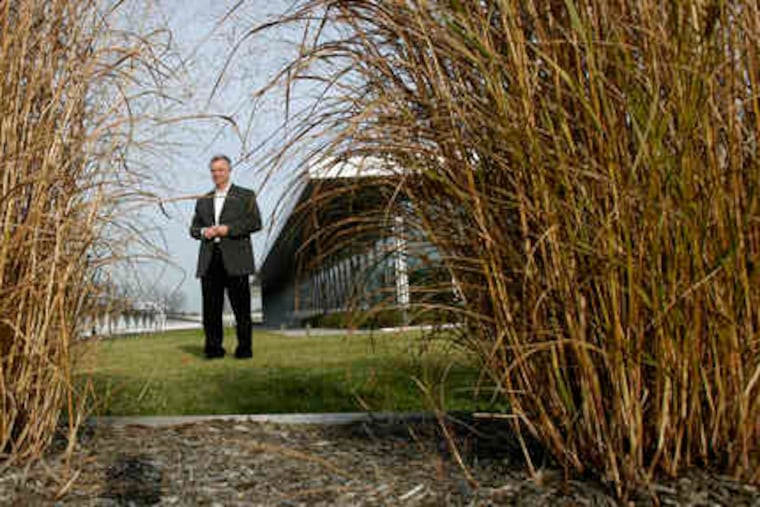Tech company SAP is living the green life
SAP America is not in the building business. Yet lately, the major buzz about the provider of information-technology systems has centered on its new headquarters in Newtown Square.

SAP America is not in the building business. Yet lately, the major buzz about the provider of information-technology systems has centered on its new headquarters in Newtown Square.
Company officials are not offended.
SAP's four-story, 218,000-square-foot monument to energy efficiency and planet protection is turning out to be a credibility booster. And that was part of the plan.
The 35-year-old company is expanding its line of software products designed to help companies go green. Erecting an office that is one of the greenest in the region was intended to demonstrate SAP's commitment to "walk the talk," said Bill McDermott, president of global field operations.
From the garden on the roof to the air-cooling ice tanks in the basement, "we really wanted to be an exemplar" of sustainability, McDermott said. "We don't just sell sustainable products, but we actually live our values and try to make the Earth a little bit better place."
Sound extraordinarily tree-huggerish? Maybe. But it is a strategy rapidly gaining traction in the business world. According to the U.S. Green Building Council, the overall green-building market (both nonresidential and residential) is expected to more than double by 2013, to $96 billion to $140 billion.
In large part, the sustainability trend is fueled by practicality. Stricter environmental regulations on emissions of greenhouse gases, for instance, are expected for business, especially big industry.
The recession and escalating energy prices have been a prod, too - inspiring a worldwide corporate search for budget-trimming options, including switching to more energy-efficient lightbulbs and replacing face-to-face meetings with videoconferencing.
Public relations is also a driver, as shareholders and customers are paying more attention to the environmental effect of a company's pursuit of profits, said Brenda Hustis Gotanda, a partner at the Bala Cynwyd law firm of Manko, Gold, Katcher & Fox L.L.P. and a specialist in sustainability.
"How they are judged by the public" on sustainability is "a really big issue" to a growing number of companies, Gotanda said.
It also matters to the supply chain - the other companies that do business with a company, said Simon Mingay, an IT analyst from Gartner U.K. Ltd. in England.
"A large portion of the [requests for proposals] these days ask environmental sustainability-related questions," Mingay said.
His analyses of software companies, including SAP, include their commitment to sustainability. On SAP, he gives an overall favorable review, with some conditions.
"Showcase things like the new 'green' building are good, so long as they are in the context of the wider strategy that tackles the material impacts of their business," Mingay wrote in an e-mail. He added that no software companies are currently giving "any serious consideration" to the environmental effect of their products.
SAP, he said, has "some smart people who are saying and starting to do the right things. . . . But those smart people need resources lined up behind them. We'll see whether they have [them] over the next 12 months."
Since opening in May, the SAP headquarters has picked up awards from environmental, architecture, and construction groups. Whether it qualifies for the highest level of sustainability certification under the U.S. Green Building Council's LEED program - platinum - is not yet known.
Few sites in the region can boast of that designation. Two in Philadelphia include Liberty Property Trust's One Crescent Drive, a four-story building at the Navy Yard Corporate Center, and the Aquatic Facility at Overbrook School for the Blind.
SAP's headquarters is a sun worshiper's - and window washer's - dream, with 80 percent of the exterior consisting of triple-pane, high-performance glass that allows more reliance on natural light and less on the kind you pay for.
According to SAP project manager Brian Barrett, the building's electrical use is averaging one kilowatt per square foot, compared with 2.5 kilowatts per square foot typical of a conventionally constructed office.
A rooftop garden of more than an acre sprouts blue fescue, lavender, and goldfinger, along with a variety of sedum. Not only is the plant life visually stunning and an ideal setting for corporate entertaining, it is expected to extend the life of the rubber roof under it by 30 years, Barrett said. The botanical covering also helps cool the floor below, he said.
Cooling and heating of the building's main floor comes from 10 geothermal wells on the back lawn that are 400 feet deep. The basement ice storage tanks cool space everywhere else in the building.
Cubicles are made from recycled parts; so is the flooring. In some areas, it is a combination of recycled glass and seashells. Many doors are made of bamboo, an eco-friendly alternative to trees because it can be regenerated relatively rapidly.
While SAP will not disclose the cost of its new building, sources familiar with the project said it was close to $90 million. McDermott said the company expected to become 40 percent to 50 percent more efficient just from savings in water use and electricity.
It all matters to Emma Stewart, even though she is 2,500 miles away in San Francisco. She is a sustainability leader at Autodesk Inc., a company that specializes in design software for the built environment, from bridges and data centers to airplanes and washing machines.
Her company wants not only to help its customers do their work in a more sustainable way, but to set an example of sustainability. SAP's commitment to those dual objectives helped convince her that it was a good fit for Autodesk, which is now using SAP's Carbon Impact, a system that helps companies determine their total carbon output.
In selecting a business partner, "I gauge not only what a company tells me [about its sustainability commitment]," Stewart said, "but what they're doing."